
The echinoderms are a group of animals that includes starfish, urchins, feather stars, and sea cucumbers. They are simple animals, lacking a brain and complex sensing organs. Echinoderms are characterized by their radial symmetry and a central mouth. Although a sea urchin looks round, closer inspection reveals that it is nothing more than a starfish with its legs wrapped inwards to form a sphere. The echinoderms are found in a stunning variety of shapes and colors, and are found decorating coral reefs around the world. Some of these animals are carnivorous, feeding on corals and scavenging the ocean floor. Certain species of starfish actually extend their stomachs into their unwary victims in order to digest them. The feather stars and sea cucumbers are mainly filter feeders, catching what ever they can find floating in the ocean currents. All of the echinoderms move around with the use of thousands of tiny tube feet, many of which have suction cups on the ends. Many of the urchins have developed extremely sharp spines as a means of protection. Below is a listing of some of the most common reef-dwelling echinoderms.
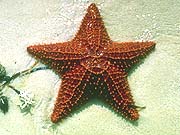
The cushion star is a thick-bodied species of starfish with short legs. It ranges in color from brown to orange, red, and yellow. Its hard shell is covered with raised knobby spines. This starfish is grows to a diameter of 10 inches, and is found on the sandy bottoms in the Atlantic waters from South Carolina to Florida. Its hard shell makes it a popular species among shell collectors.
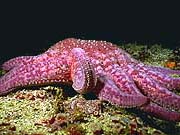
The sunflower star is among the larger of the starfish species. With its 24 arms, it can reach a diameter of over 2 feet! The color of this starfish can range from purple to red, pink, brown, orange, and yellow. It is common along the Pacific coast and can be found along the rocky sea bottoms from Alaska to southern California.
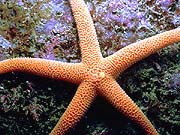
This brightly colored starfish is a common species found along the western coast of the United States and Canada. It can range in color from red to orange, yellow, and purple. This starfish grows to a diameter of about 8 inches, and is found under rocks where it feeds on small sponges and algae.
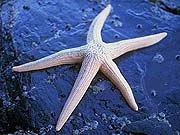
The short spined starfish is a coldwater species found in the the northeast Pacific Ocean. The color of this species ranges from pale pink to bright pink. It can reach a diameter of two feet while weighing up to two pounds, and has spines less than 2 mm long. It has a soft, flabby texture that allows it to bend slightly to stay on coral. It can typically be found scavenging along the rocky sea bottom.
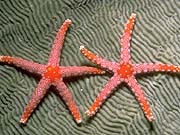
This colorful orange and red starfish is one of the most common species. Its colorful markings and docile nature make it quite popular among aquarium hobbyists. This starfish grows to about 4 inches in diameter, and is commonly found in the Indian Ocean near Indonesia where is feeds on small sponges and algae.
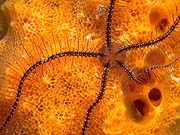
This small starfish is characterized by five long, thin arms protruding from a central disk. The arms grow to a length of 5 inches (12 cm), and can vary in color from pale mauve, pink, yellow, red or brown. This species is common in the Caribbean Sea and Gulf of Mexico. It can usually always be found among sponges such as the red tree sponge. It feeds on plankton and suspended particles that float past.
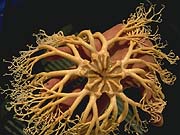
The basket star is a species with a quite alien look. They are common throughout the Caribbean region. The arms of the basket star can reach a length of 20 inches, and are used to filter plankton and other small organisms from the water. It is a nocturnal animal, feeding at night and wrapping itself into a tight ball during the day.
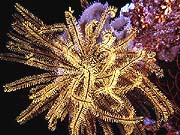
The feather starfish is an unusual species that looks more like a plant than a starfish. It ranges in color from brown to orange, yellow, and black. Like the basket star, the feather starfish is a filter feeder. It is nocturnal, and at night it can be found with its long arms unfurled where it filters plankton from the water.
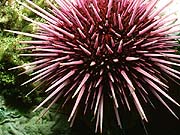
The purple sea urchin is one of the sharp-spined urchin species. The spines are used as a means of defense against would-be predators. This urchin is deep purple in color, and grows to a diameter of about 4 inches. The are found along the western coast of the United States and Canada where they clink to depressions in the rocks during low tide.
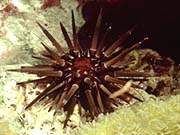
This species of urchin is common in the waters of the Caribbean and the Gulf of Mexico. It grows to a diameter of 2 inches, and ranges in color from red to brown and black. It has large, sharp spines about 3/4 inches long. This urchin can be found in burrows in the rocks, which are created by the scraping action of its teeth.
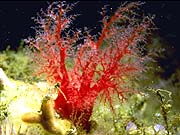
The slipper sea cucumber has a flat-bottomed oval shape to its body. This differs from most others, which have an elongated shape similar to that of a cucumber. Sea cucumbers use their feather-like arms to filter plankton from the water. This species is found all along the Pacific coast of North America.
Sponges & Sea Squirts | Corals & Anemones | Sea Worms | Echinoderms
Crustaceans | Mollusks | Coral Reef Fishes | Unusual Reef Fishes
Sharks & Rays | Marine Reptiles | Marine Mammals